While many businesses went down or struggled to stay afloat over the past year, a small number are emerging from the pandemic in better shape than they went in. How did these businesses achieve growth rates that would have been difficult without last year’s disruptions? And, what lessons can we learn from them to lead through forthcoming storms?
The Hinge Research Institute has just released the law firm edition of the High Growth Study 2021. This year’s annual study surveyed respondents from 101 law firms of all sizes. It covers topics such as the impact of COVID-19 and automation technology, firms’ biggest challenges, future priorities, and how they fared compared to professional services firms in other industries such as accounting and financial services, technology services, and consulting. The study takes a special look at the strategies and techniques of law firms that enjoyed a compound annual growth rate of 20% or greater, which we call High Growth firms. You’ll learn how these firms thrived amid an economic meltdown—and what strategies your firm could adopt to grow through even the most challenging circumstances.
High Growth Firms and How They Achieved Extraordinary Growth in 2020
High growth (HG) law firms grew at a median rate of nearly 26%. For perspective, average growth firms grew at only 11.5% while the no growth group watched their revenues contract by 3%.
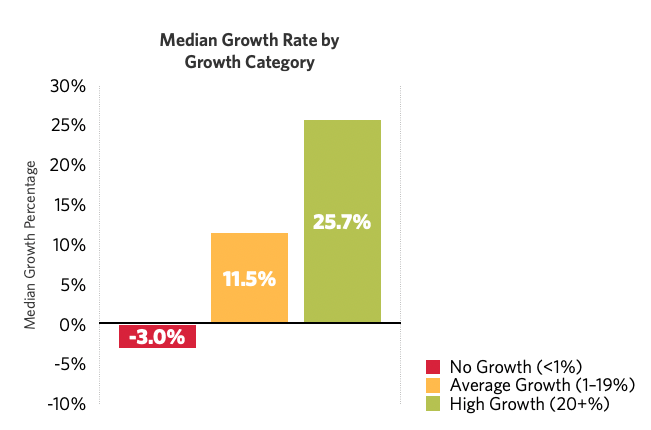
So what explains HG firms’s extraordinary growth? How did they pull far ahead of their peers despite an economic calamity that spanned the world?
Let’s start with what doesn’t explain their growth.
HG firms didn’t forego profitability for growth. In fact, they were more likely to achieve high profits than either of the other two groups. Nearly three in 10 had average profitability, but close to four in 10 were highly profitable. By contrast, no growth (NG) firms were eight times more likely to see low profits.

Nor did they derive much of their growth from M&A activity, which accounted for only 23% of their revenue.
Size didn’t matter either, as HG firms came in all sizes. However, the largest number fell under the mid-size category with 100-499 employees and revenues between $5-50M.
Perhaps the most important factor was HG firms’ ability to get ahead of a rapidly changing, unpredictable marketplace and put clients’ evolving needs front and center.
Frequent Research
2020’s unpredictable environment was less acute for HG firms, who used research to keep track of their target audiences’ shifting issues and priorities. HG firms were twice as likely as NG firms to conduct research and were slightly more likely to conduct their research at least once a quarter. This target audience research helped HG firms lower risk and identify new opportunities.
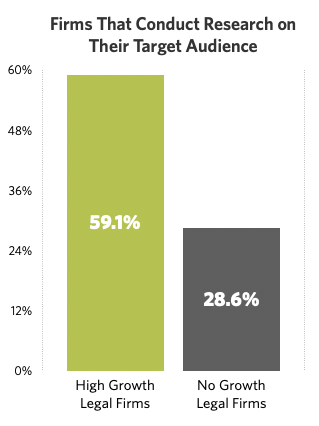
Higher Marketing Investments
As face-to-face events shut down, HG firms accelerated their online marketing efforts. On average, their marketing budgets were 27% of revenue—48% more than NG firms. It’s interesting to note that despite their bigger marketing outlays, HG firms were far more profitable than NG firms. Clearly, HG firms’ marketing investment propelled their business development efforts.
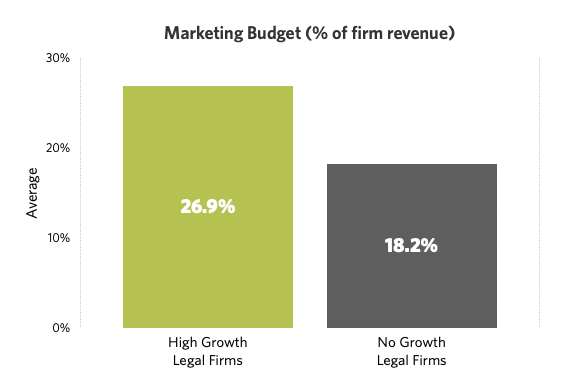
Marketing Techniques and Their Impact
HG firms put more effort into a broader range of marketing techniques than NG firms did. They also used these techniques more frequently. Email marketing and networking on social media tied for the top spot. Marketing videos and marketing partnerships tied for second place. Podcasts and other audio formats came in third.
However, frequency and effort did not translate to impact. How they used them was just as important. The most effective techniques were:
- Keyword research/search engine optimization (SEO)
- Podcasts, radio, or other audio formats
- Speaking at targeted conferences or events (including virtual or online)
(To see the complete list of marketing techniques—as well those that generate the best results for the least effort—check out the full study.)
It’s clear that HG firms focused on sharing valuable information with their target audience at a time when the latter needed help coping with new challenges. And as gatherings and communications shifted online, HG firms ensured that their insights would be where their audiences were searching. However, it’s worth noting that although keyword research and SEO surged to the top spot for its impact, only one-third of all law firms used it as a technique. We’ll find out why below.
Better Marketing Skills
HG firms invest in better marketing talent. They rated their marketing functions’ capabilities higher across all skills areas than NG firms did theirs. The gaps partly explain why the impact of NG firms’ marketing efforts fell below that of HG firms. Not only did HG firms put in more effort, their marketing expertise enabled them to use the techniques to greater effect.
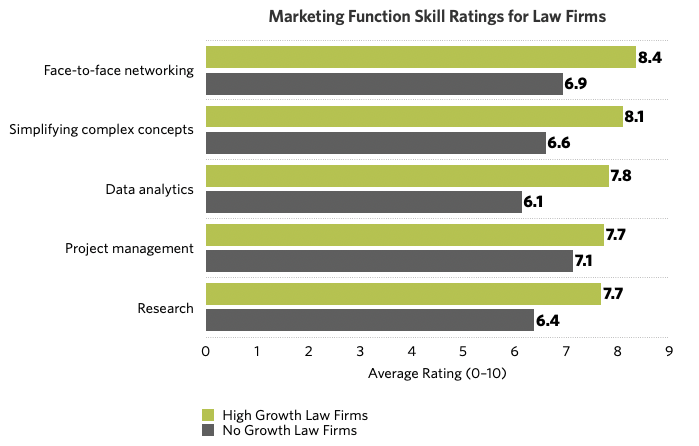
There is one area where HG firms have only a slight advantage over NG firms: keyword research and SEO, one of the most technical areas in marketing today. It requires a broad range of technical skills and the right set of tools. But as marketing campaigns rely increasingly on digital channels, SEO will play a more crucial role in reaching audiences. In the short- and long-run, the cost of scrimping on SEO will outweigh the cost of building up that capability inhouse or outsourcing it. Since only 21% of firms plan to spend more on SEO, firms that ramp up their SEO strategy can potentially leapfrog or widen the gap with competitors in digital lead generation.
Focus on Digital Lead Generation
In a contactless world, prospects can only find you online. HG firms generate 43% of their leads through digital marketing, or 24% more than NG firms. Their advantage over their average- and no-growth peers in digital marketing is a major factor behind their growth. As prospective clients search the internet for solutions to their newfound issues, the law firms that produce easy-to-find educational content on those issues have a distinct advantage when it comes to earning their audience’s trust and winning their business.
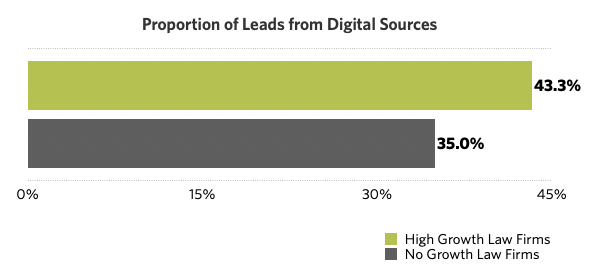
More and Better Use of Technology
HG firms enjoy advantages over their slower growing peers not only in marketing but in their adoption of automation technology for core business processes. Their automation strategies are 65% more mature than NG firms’. Because the HG firms’ core business processes make full use of automation technology, their people are freed to focus on more strategic work and deliver better, more efficient service to clients.
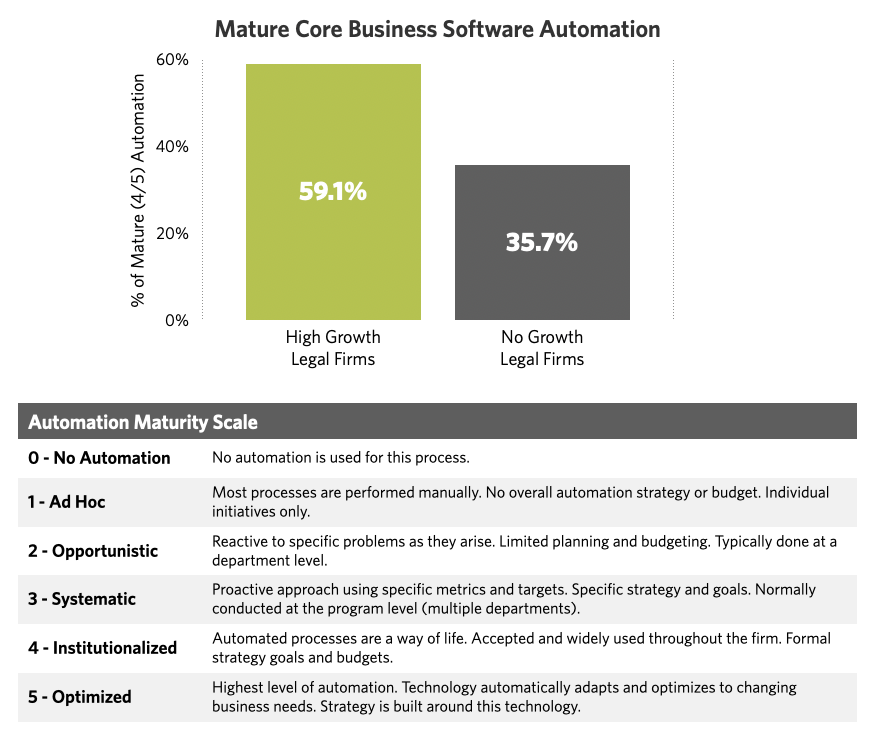
Just as important, HG firms’ use of automation and digital marketing equips them to work from just about anywhere. Close to 32% of HG firms and only 7% of NG firms plan to work fully remote, suggesting that HG firms are preparing for a future where acquiring the best—and, perhaps, most cost-effective—talent in the world is more important than having teams in the same office. These firms will have an edge over their less flexible peers in the war for talent and business.
Conclusion
What can we learn from the high growth firms? What has worked? These firms embrace research, and as a result they are better able to keep up with their buyers’ changing needs. Equipped with data-driven insights their competitors don’t have, they use a broader array of digital marketing techniques that help them generate more digital leads, even as the world economy grinds to a halt. Equally important is their wider use of automation in marketing and core business processes, enabling them to do more, faster, and for less.
If these firms can grow during last year’s tempest, they’re likely poised to weather many of the storms ahead.
Additional Resources
Join the High Growth law firms who use research to guide their marketing and business development efforts by purchasing this full research study here.




